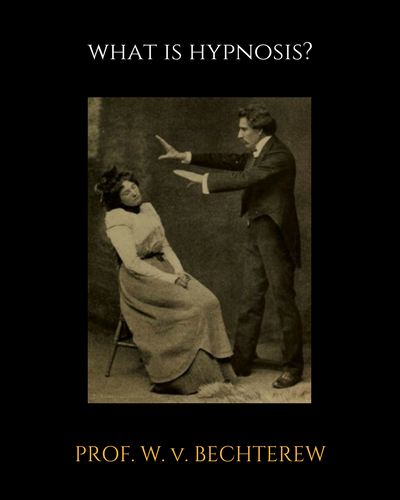Psychology Classics On Amazon

What is Hypnosis?
Originally published in the Journal of Abnormal Psychology in 1906, this classic article reviews the history of hypnotism.
The Article in Full
We can review in short the history of hypnotism. Hypnotism and suggestion were undoubtedly known in ancient times, for the Egyptian priests made use of them. The history of the ancient orient reveals many examples of the use of hypnosis and suggestion in religious ceremonies. Knowledge of them was present in the time of the apostles. Their popularity was established among the priests, medical men, magicians, sorcerers, under the mark of influences coming from the gods, or from charms, exorcisms, and so on.
Hypnotism and the power of suggestion afterwards took refuge among the cultivated classes of European society, under the cloak of black magic, the so-called animal magnetism, mesmerism with its fluids, and other occult doctrines. This was greatly favored by the activity of charlatans and adventurers who presented the real manifestations of hypnosis in such an irrational way that it was almost impossible to distinguish between truth and deception. Such was the history of mesmerism which the learned academy of Paris declared unworthy of the attention of the scientific world.
In the course of the last century the concepts of hypnotism and suggestion came to the foreground among the cultivated public, owing largely to intercommunication between Europe and India with her mystic fakirs, who, to the present day, exhibit openly in the market place, for a small remuneration, the mysteries of hypnosis to the delight of the populace.
It is not long since hypnosis was regarded as a dark power. The scientific world looked upon hypnosis as something that did not belong to the great family of science. But the progress of time could not be arrested, and over and over again did the cultivated European classes make acquaintance with the phenomena of hypnotism, especially the rough practical business hypnotists, who gave "hypnotic seances" for the benefit of the public at large. Among the hypnotists, aside from Mesmer, we may mention the name of Hansen who, through his stances and hypnotic demonstrations, which he carried on throughout the extent of Europe, strangely awakened the interest of physicians and physiologists in behalf of hypnotism.
Marquis Puisegure, a pupil of Mesmer, discovered the importance of hypnotic sleep, of that sleeplike state in which the will of the subject becomes subordinate to that of the hypnotizer. One of the first scientists who formed a clear conception of hypnotism was Braid, 1843, but even after that a long time passed away before hypnotism could expect a scientific investigation, and as such belong to the sciences to which serious investigators were willing to turn their attention, or to devote themselves.
This is easy to understand, because many people of high standing regarded it for a long time as a simple deception, or, at least, as such a mysterious affair that it did not appear to deserve real study. Liébeault, the French physician of Nancy, practiced a long time in practical therapeutics by hypnotic suggestion, and published a comprehensive book on the subject; in spite of all that, the doctrine of hypnotism and its power of cure remained in its previous status. It required the authority of one of the foremost clinicians, such as Charcot, to interest scientists and physicians and clear the study of hypnosis from a great number of prejudices which one had to encounter.
Great, however, as Charcot's merit and the investigation of hypnotism and the elucidation of its medical and scientific worth may be, still the practical application of hypnosis for therapeutic purposes is especially represented by the School of Nancy, of which the foremost representative is Bernheim, who has developed it further on the lines laid down by Liébeault. The doctrine of modern hypnotism may be identified with the names of Braid, Liébeault, Charcot, and Bernheim. Of other scientists who greatly contributed to the development of the doctrine, we may mention the names of Azam, Durand de Gros, Dumontpallier, H. Tuke, Regnard, Farez, Richet, Pitres, Voisin, Luys, Liégeois, Bérillon, von Krafft-Ebing, von Schrenck-Notzing, Moll, Grasset, and many others; also many Russian investigators who, although they came rather late, have nevertheless richly contributed to the investigation of hypnosis.
In spite, however, of the enormous literature on the subject, there are some essential questions which until now have not been answered.
From the very beginning of the scientific development of hypnotism there was a split between Charcot and Bernheim, — a split that gave rise to the formation of two separate schools. The school at the head of which stood the late Charcot favored more the physical, while the other, that of Bernheim, maintained the psychological point of view. The old mesmeric fluid hypothesis can no longer be maintained, although it may find, perhaps, a foothold among professional hypnotists. With the death of Luys, its only scientific representative, it is no longer taken seriously by any scientific investigator.
Scientific investigations have thus given us two schools. The difference between them may be expressed in the following statement:
According to Charcot the state of hypnosis is nothing but an artificial or an experimental nervous condition, a neurosis brought about artificially and akin to hysteria, the various manifestations of which can be aroused at the will of the hypnotizer both by physical and psychical means. The typical hypnosis, declares this school, consists of three phases: a lethargic, cataleptic, and somnambulic, each having its own peculiar characteristics. The lethargic, for example, is characterized by flaccidity of the body, heightening of neuropsychic excitability, and insusceptibility to suggestion. The cataleptic is distinguished by manifestations of catalepsy, tendency to paralysis, and suggestibility. Finally, the somnambulic phase is characterized by contractures on irritation of the skin, hyperesthesia, and manifestations of various automatisms following suggestions. Any one of the three phases can appear first, and the hypnotized person by different means can be changed from one to another. Thus, when the subject in the lethargic state has his eyes open, he becomes cataleptic, and if the spine is rubbed he passes into the somnambulic state. Still, even Charcot thought that these phases were not often met with, but that they were typical and could be taken as general characteristics of the hypnotic state.
The views of Bernheim and of the Nancy School are quite different from those of Charcot. Hypnosis, according to the Nancy School, is to be. regarded as sleep, which is induced by suggestion. There is no relation between hysteria and hypnosis. All the manifestations of hypnosis depend entirely on suggestion which especially characterizes the hypnotic state. The stages of hypnosis differ by the depth of sleep and by a greater or lesser susceptibility to suggestion. Persons who are in a state of hypnosis are subject to suggestion in different degrees. If the subject is in the hypnotic state and we close his eyes, then, according to Bernheim, the attention of the subject is concentrated upon the hypnotizer, and is controlled by suggestion. There is no need of closing the eyes in order to induce another stage, nor is there any need to rub the spine; it is enough to give a verbal suggestion to the subject to bring about the same results. There is nothing but suggestion in the Salpêtrière manipulations which, in themselves, are powerless to evoke hypnosis or change it in the slightest degree. The hysterical patients of the Salpêtrière were specially educated by a long course of training to react in certain definite ways when in the hypnotic state.
The Nancy School also recognizes stages of hypnosis, but they are classified according to the depth of sleep, the depth of amnesia, or, finally, according to the stage of susceptibility to suggestion. Various classifications of hypnotic stages have been advanced by the representatives of the Nancy School, but according to Bernheim all those distinctions are more or less artificial and conditional and justified on practical grounds alone.
Let us now consider the essential points of opposition of the two schools: Can we regard the hypnotic condition as a neurosis, as a neurotic state closely allied to that of hysteria? There is no doubt that this standpoint is against facts, because hypnosis, as we know it now, can be induced in most men, and we cannot possibly regard most of humanity as hysterical. It has also been demonstrated that although hysterical patients may present classical hypnotic states, deep hypnosis may be presented by subjects who neither suffer from hysteria nor have the least indications of hysterical stigmata. Besides, hypnosis has also been induced in animals where hysteria is out of the question.
The psychological school, however, that refers all hypnotic phenomena to suggestion, is also one-sided, inasmuch as it overlooks the physiological side and attempts to explain all the facts by suggestion. Now many facts of hypnosis cannot be explained by suggestion. There are many cases where hypnosis is evoked by purely physical means without the least intervention of suggestion. Thus, in a case of mine, by taking the knee reflex I accidentally brought about a deep hypnotic state in an official, a patient of mine, who suffered from tuberculosis of the spine, with motor and sensory paralysis of the legs. The patient did not understand Russian and had no knowledge of hypnosis. Our object was to test for reflexes and not to induce the hypnotic state, and yet, to our great bewilderment, the patient fell into a deep sleep in less than a quarter of an hour. That it was an actual hypnotic state could be proved by the fact that we could induce in the subject olfactory and gustatory hallucinations, and that we could also give successfully post-hypnotic suggestions.
Another case is that of an educated neurologist who understood well the phenomena of hypnosis and who suffered from a severe disease of the spine, with paralysis, contracture, and complete anesthesia of both legs. The patient was ordered passive gymnastics of the feet and passive extension of the contracted knees. Now it turned out that passive feet gymnastics put the patient, within fifteen minutes, into a deep sleep, during which the pain on extension of the contracted knees was no longer experienced. The patient himself was very much astonished, all the more so as the regular methodical suggestion (after Bernheim) could, hardly put him into a slight hypnotic state, during which there was no loss of pain that might permit the forcible extension of the knees.
We have here, then, cases in which hypnosis could be induced by physical means as well as by means of suggestion. As in the case of the testing of reflexes, so also in the last case, the physical influence cannot possibly be referred to simple suggestion. This clearly contradicts the doctrine that hypnosis is entirely a matter of suggestion. Again, hypnotic experiments on children without any verbal suggestion clearly prove that hypnosis is not necessarily conditioned by suggestion. Finally, an irrefutable proof of the position taken by me can be found in the hypnotic manifestations induced by purely physical manipulations.
In short, although hypnosis is easily induced by suggestion, still in some cases it can be induced by physical means without the least intervention of suggestion. From this standpoint Bernheim's definition of hypnosis as suggested sleep may be regarded as one-sided. I regard hypnosis not as suggested sleep, but as a special modification of normal sleep which can be induced by physical as well as by psychical means. The ordinary normal sleep reaches in most people such a depth that the influence of suggestion is impossible. There are, however, people with whom we can enter into relation when they are fast asleep and to whom we can give successfully all kinds of suggestions. We thus have here normal sleep with all the peculiarities characteristic of the hypnotic sleep. A similar suggestible state is also met with in persons as the result of certain conditions, such as great bodily fatigue. In some, again, such a state of suggestibility is present at the beginning of deep sleep. It is also known that in the first stages of chloroform narcosis the patient can be spoken to and can even be influenced by suggestion. Recently, a new narcotic, named somnaphor, has been utilized for the induction of the hypnotic state. From all this, according to my view, it follows that hypnosis is nothing but a modification of normal sleep.
We can also finally bring in favor of our view the fact that in hypnosis we can reproduce dreams that have taken place in normal sleep, dreams which have been forgotten in the waking state. Those who find difficulty in the objection that in hypnosis the subject can act, which is not the case in normal sleep, should keep in mind the well-known manifestations of normal somnambulism, in which the person can walk and act, and then forget completely all that has occurred.
While the memories of such somnambulistic states are not retained under normal conditions, the hypnotic subject can remind himself of what has taken place in the condition of natural somnambulism. In 1892, I exhibited before the Neuropathological and Psychiatric Society, at Kasan a case of this kind. It was the case of a patient who made nightly excursions in her natural sleep and who could not remember on awakening what had taken place, although, in one of her peregrinations, on a very frosty night, she had wandered through many streets and had had her hands frozen; on another similar occasion she hurt her thumb in an attempt to uncover an old well. In hypnosis, however, she could remember all her nightly wanderings in the state of natural somnambulism, and could give a detailed account of her experiences. Similar observations have been reported by others later on. Such cases clearly prove that hypnosis is only a modification of normal sleep which, in its deeper stages, is closely allied to natural somnambulism, and in its milder stages corresponds to light sleep or slumber.
From this standpoint the opposing views of the two schools can, in some way, be reconciled. For, regarded as a modification of normal sleep, hypnosis is a, widespread phenomenon which not only can be evoked in most people, but which can also be induced in animals. From this point of view hypnosis need not be regarded as a manifestation of disease.
On the other hand, the deep stages of hypnosis are closely allied to natural somnambulism, and hence may almost be regarded as abnormal manifestations. That the same phenomena may be on the border line, approaching now the normal and now the abnormal, is quite conceivable if we remember that every pathological state is only an intensification or modification of a normal state. This holds true of the various manifestations of ordinary sleep. We should keep in mind the state of slumber with its dreams. This modification of normal sleep no one can regard as abnormal or pathological. On the other hand, there is a manifestation of normal sleep in which the sleeper can speak, walk, and act. This natural somnambulism, a modification of normal sleep, is, in reality, something which passes the limits of the normal and approaches closely certain neurotic states which, as in hysteria, with its well-known attacks and manifestations, strongly remind us of similar sleep states.
This Psychology Symbol - Vintage Retro Striped Sunset T-Shirt is available from Amazon (prime eligible) in a range of colors for women and men. Sales help support this website, which has been providing free and comprehensive information and resources for psychology students and educators since 2008.
Recent Articles
-
5 Tips for Keeping Your Elderly Loved Ones Safe
Apr 15, 24 10:30 AM
Insightful article outlining 5 tips for keeping your elderly loved ones safe -
Unlocking the Mental Health Benefits of Cold Plunge
Apr 14, 24 09:52 AM
Great article exploring the mental health benefits of benefits of cold plunge water immersion. -
The Hidden Meanings Behind Colors A Guide to Color Psychology
Apr 13, 24 08:23 AM
The Hidden Meanings Behind Colors A Guide to Color Psychology. Learn the psychological effects of colors and how they impact your daily life. Discover the hidden meanings behind the colors you see.
Please help support this website by visiting the All About Psychology Amazon Store to check out an awesome collection of psychology books, gifts and T-shirts.
Go Back To The Classic Psychology Journal Articles Page
Go From What is Hypnosis Back To The Home Page






